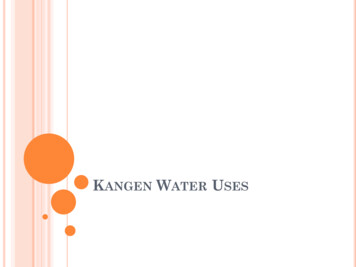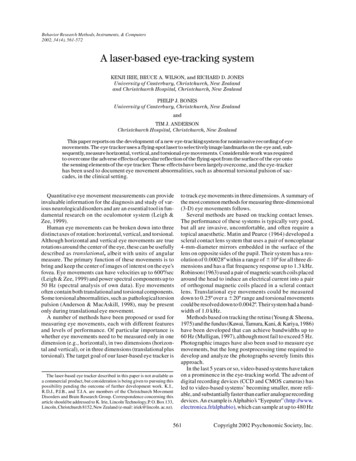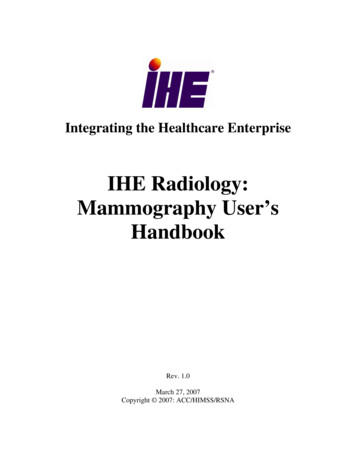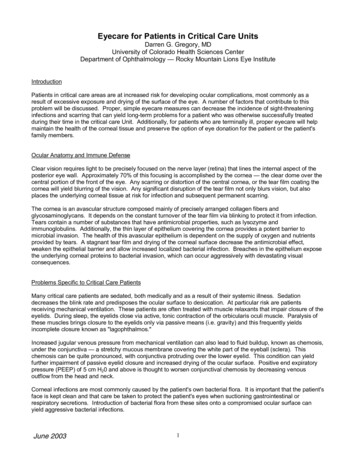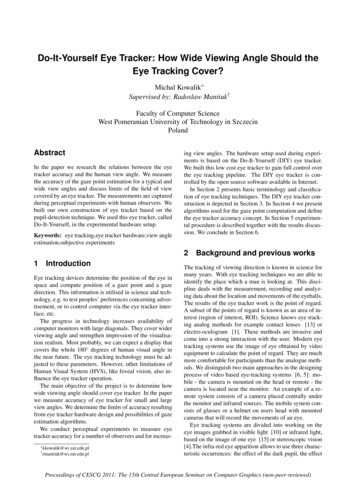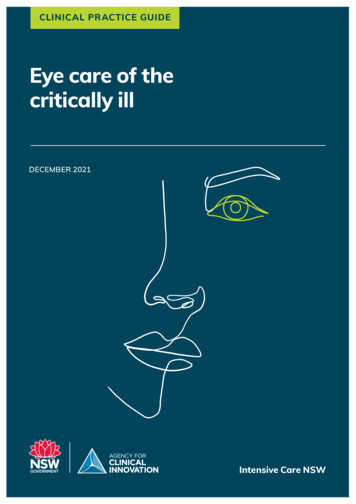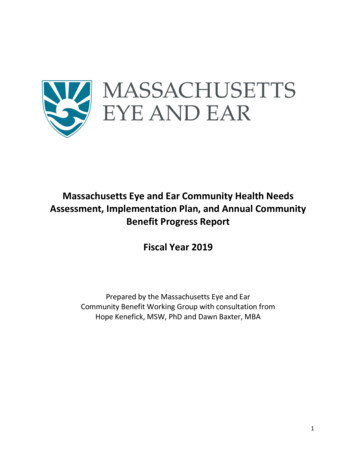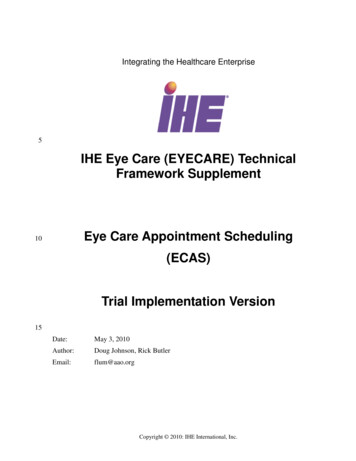
Transcription
Integrating the Healthcare Enterprise5IHE Eye Care (EYECARE) TechnicalFramework SupplementEye Care Appointment Scheduling10(ECAS)Trial Implementation Version15Date:May 3, 2010Author:Doug Johnson, Rick ButlerEmail:flum@aao.orgCopyright 2010: IHE International, Inc.
IHE Technical Framework Supplement – Eye Care Appointment Scheduling (ECAS)20ForewordThis is a supplement to the IHE Eye Care Technical Framework, V3.7. Each supplementundergoes a process of public comment and trial implementation before being incorporated intothe volumes of the Technical Frameworks.2530This supplement is submitted for Trial Implementation as of May 3, 2010 and will be availablefor testing at subsequent IHE Connectathons. The supplement may be amended based on theresults of testing. Following successful testing it will be incorporated into the Eye CareTechnical Framework. Comments are invited and may be submitted on the IHE forums athttp://forums.rsna.org or by email to eyecare@ihe.net.This supplement describes changes to the existing technical framework documents and whereindicated amends text by addition (bold underline) or removal (bold strikethrough), as well asaddition of large new sections introduced by editor’s instructions to “add new text” or similar,which for readability are not bolded or underlined.“Boxed” instructions like the sample below indicate to the Volume Editor how to integrate therelevant section(s) into the relevant Technical Framework volume:35Replace Section X.X by the following:General information about IHE can be found at: www.ihe.netInformation about the IHE Eye Care can be found at: http://www.ihe.net/Domains/index.cfm40Information about the structure of IHE Technical Frameworks and Supplements can be found at:http://www.ihe.net/About/process.cfm and http://www.ihe.net/profiles/index.cfmThe current version of the IHE Technical Framework can be found at:http://www.ihe.net/Technical Framework/index.cfm1 Rev. 1.0 - 2010-04-01 Copyright 2010: IHE International, Inc.
IHE Technical Framework Supplement – Eye Care Appointment Scheduling (ECAS)45505560657075CONTENTSIntroduction .3Profile Abstract .3Open Issues and Questions .3Closed Issues 3Volume 1 – Integration Profiles .41.7 History of Annual Changes .41.9 Copyright Permission 42.1 Dependencies among Integration Profiles 42.2.5 Eye Care Appointment Scheduling (ECAS) .47 Eye Care Appointment Scheduling (ECAS) .77.1 ECAS Actors/Transactions 77.2 ECAS Integration Profile Options .97.3 ECAS Process Flow .97.4 ECAS Security Considerations .15 Appendix A Actor Summary Definitions .15 Appendix B Transaction Summary Definitions 15Volume 2- Transactions .174.12 Appointment Request .174.12.1 Scope 174.12.2 Use Case Roles .174.12.3 Referenced Standard .174.12.4 Interaction Diagram . 174.13 Appointment Notification .274.13.1 Scope .274.13.2 Use Case Roles .274.13.3 Referenced Standard .274.13.4 Interaction Diagram . 274.14 Schedule Query . .344.14.1 Scope 344.14.2 Use Case Roles .354.14.3 Referenced Standard . 354.14.4 Interaction Diagram . 35802 Rev. 1.0 - 2010-04-01 Copyright 2010: IHE International, Inc.
IHE Technical Framework Supplement – Eye Care Appointment Scheduling (ECAS)Introduction85This supplement, IHE EYECARE Technical Framework Supplement - Eye Care AppointmentScheduling, adds a new profile to the existing IHE Eye Care Technical Framework and two newactors. The Eye Care Appointment Scheduling Profile (ECAS) describes mechanisms to allow ahealthcare provider to request an appointment and to request and receive appointmentinformation within an eye care clinic. The Appointment Scheduler is a new actor which is responsible for receiving requests forappointments and appointment information and returning the information to therequester. The Appointment Requester is a new actor which gives the user the ability to request anappointment and to request information about appointments that have been scheduled. Itis also responsible to maintain the current status of any appointment request which itoriginated.9095Profile Abstract100105110The Eye Care Appointment Scheduling Profile specifies the creation of a scheduling informationexchange between a master appointment schedule and a working healthcare provider recognizingthat often the master schedule and the personnel who operate it may not be readily available atthe provider’s location. It also defines the communication between patient registration systemsand the appointment scheduling system about patient demographics. The Eye Care AppointmentRequest contains all of the required data needed to request a patient appointment. The Eye CareAppointment Response has all of the required data to confirm that an appointment with thedesired criteria has been created or that the appointment could not be set as requested. The goalsof including these transactions in the IHE Technical Framework include standardizing the meansof requesting patient appointments, minimizing the time needed for these requests, maintainingboth the flexibility and the specificity needed for appointment scheduling in a clinicalenvironment while increasing the accuracy of both the request and the response, and giving thehealthcare provider a means to determine if the scheduling request has or has not been filled.Additionally the Scheduling Profile allows the healthcare provider to view schedules based onrequested criteria.Open Issues and QuestionsNone115Closed IssuesNone3 Rev. 1.0 - 2010-04-01 Copyright 2010: IHE International, Inc.
IHE Technical Framework Supplement – Eye Care Appointment Scheduling (ECAS)Volume 1 – Integration Profiles1.7 History of Annual Changes120Add the following bullet to the end of the bullet list in section 1.7 125130A supplement has been drafted in the 2010 development cycle of the Eye Care Domain. Itwill be the basis for the testing at IHE Connectathons beginning in 2010. The current IHETechnical Framework adds the following primary features to those of previous years: Addedthe Eye Care Appointment Scheduling Profile which allows the creation of a schedulinginformation exchange between a master appointment schedule and a working healthcareprovider recognizing that often the master schedule and the personnel who operate it may notbe readily available at the provider’s location. It also defines the communication betweenpatient registration systems and the appointment scheduling system about patientdemographics.1.9 Copyright PermissionNo additional copyright permission for Eye Care Appointment Scheduling Profile, beyond thosedescribed in 1.9 of EYECARE TF:1were deemed necessary.2.1 Dependencies among Integration Profiles135Add the following to Figure 2-1Eye Care Appointment SchedulingManage and exchange appointmentinformationAdd the following to Table 2-1Eye Care Appointment Scheduling140NoneNoneNoneAdd the following section to section 2.24 Rev. 1.0 - 2010-04-01 Copyright 2010: IHE International, Inc.
IHE Technical Framework Supplement – Eye Care Appointment Scheduling (ECAS)2.2.5 Eye Care Appointment Scheduling (ECAS)145150155The Eye Care Appointment Scheduling Profile specifies the creation of a scheduling informationexchange between a master appointment schedule and a working healthcare provider recognizing thatoften the master schedule and the personnel who operate it may not be readily available at theprovider’s location. It also defines the communication between patient registration systems and theappointment scheduling system about patient demographics. The Eye Care Appointment Requestcontains all of the required data needed to request a patient appointment. The Eye Care AppointmentResponse has all of the required data to confirm that an appointment with the desired criteria hasbeen created or that the appointment could not be set as requested. The goals of including thesetransactions in the IHE Technical Framework include standardizing the means of requesting patientappointments, minimizing the time needed for these requests, maintaining both the flexibility and thespecificity needed for appointment scheduling in a clinical environment while increasing theaccuracy of both the request and the response, and giving the healthcare provider a means todetermine if the scheduling request has or has not been filled. Additionally the Scheduling Profileallows the healthcare provider to view schedules based on requested criteria.Add Appointment Scheduler Actor and Appointment Requester Actor to Actor Section 2.3 ActorDescriptions2.3 Actor Descriptions160165ADT/Patient Registration - A system responsible for adding and/or updating patientdemographic and encounter information (Admission/Discharge/Transfer). Inparticular, it registers a new patient with the Order Placer and Department System.Some possible eye care examples include a Practice Management System (PMS) or aHospital Information System (HIS).Appointment Scheduler - A system that handles requests for appointments andrequests for appointment information. The system is responsible for providingschedule information including appointments requested by the AppointmentRequester Actor and those that were not.Appointment Requester - A system that sends requests for appointments and/orschedules and displays the results of those requests.170Charge Processor - Receives the posted charges and serves as a component of thefinancial system (for instance a PMS or billing system).Add Appointment Scheduling Profile and Actors to Table 2.3-15 Rev. 1.0 - 2010-04-01 Copyright 2010: IHE International, Inc.
IHE Technical Framework Supplement – Eye Care Appointment Scheduling (ECAS)Table 2.3-1. Integration Profile ActorsIntegration ProfileActorEYE CAREWorkflowEye CareEye CareCharge Posting EvidenceDocument ADT Patient RegistrationXX Eye CareEye CareDisplayable AppointmentReportScheduling .XAppointment RequesterXAppointment SchedulerX .175 .Add Appointment Request, Appointment Notification and Schedule Query to section 2.4 TransactionDescriptions2.4 Transaction DescriptionsRetrieve Displayable Reports – A Report Reader requests and retrieves a diagnosticreport from the Report Repository. [EYECARE-9]180Appointment Request - The Appointment Requester requests a patient appointmentwith varying specificity of detail as to date range and purpose of the visit. TheAppointment Scheduler receives and acknowledges the request, then either fillsthe request, returning the appointment, or denies the request. [EYECARE-12]Appointment Notification - The Appointment Scheduler sends information to theAppointment Requester for any change to the schedule, including appointmentsadded, updated or cancelled. [EYECARE-13]185Schedule Query - The Appointment Requester queries the Appointment Schedulerfor a schedule based on specified parameters. The Appointment Schedulerreturns the result of the query and the Appointment Requester displays thereturned schedule. [EYECARE-14]190Add Appointment Scheduling Profile and Transactions to Table 2.4-1Table 2.4-1. Integration Profile TransactionsIntegration ProfileTransaction EYE CAREWorkflowEye CareEye CareCharge Posting EvidenceDocument Eye CareEye CareDisplayable AppointmentReportScheduling .Appointment NotificationXAppointment RequestXSchedule QueryX1956 Rev. 1.0 - 2010-04-01 Copyright 2010: IHE International, Inc.
IHE Technical Framework Supplement – Eye Care Appointment Scheduling (ECAS)Add Section 77 Eye Care Appointment Scheduling (ECAS)200205210The Eye Care Appointment Scheduling Profile specifies the creation of a scheduling informationexchange between a master appointment schedule and a working healthcare provider recognizingthat often the master schedule and the personnel who operate it may not be readily available atthe provider’s location. It also defines the communication between patient registration systemsand the appointment scheduling system about patient demographics. The Eye Care AppointmentRequest contains all of the required data needed to request a patient appointment. The Eye CareAppointment Response has all of the required data to confirm that an appointment with thedesired criteria has been created or that the appointment could not be set as requested. The goalsof including these transactions in the IHE Technical Framework include standardizing the meansof requesting patient appointments, minimizing the time needed for these requests, maintainingboth the flexibility and the specificity needed for appointment scheduling in a clinicalenvironment while increasing the accuracy of both the request and the response, and giving thehealthcare provider a means to determine if the scheduling request has or has not been filled.Additionally the Scheduling Profile allows the healthcare provider to view schedules based onrequested criteria.7.1 Actors/ Transactions215Figure 7.1-1 shows the actors directly involved in the Eye Care Appointment SchedulingIntegration Profile and the relevant transactions between them.7 Rev. 1.0 - 2010-04-01 Copyright 2010: IHE International, Inc.
IHE Technical Framework Supplement – Eye Care Appointment Scheduling (ECAS)AppointmentScheduler Patient Registration [RAD-1]ADT Provider Patient Update [RAD-12] Appointment Notification [EYECARE-13] Appointment Request [EYECARE-12] Schedule Query [EYECARE-14] Patient Registration [RAD-1] Patient Update [RAD-12]AppointmentRequesterFigure 7.1-1. Eye Care Appointment Scheduling Actor Diagram220Table 7.1-1 lists the transactions for each actor directly involved in the Eye Care AppointmentScheduling Profile. In order to claim support of this Integration Profile, an implementation mustperform the required transactions (labeled “R”).225Table 7.1-1. Eye Care Appointment Scheduling Integration Profile - Actors andTransactionsActorsADT PatientTransactionsPatient Registration [RAD-1]OptionalityRSection in Vol. 2RAD TF- 2:4.18 Rev. 1.0 - 2010-04-01 Copyright 2010: IHE International, Inc.
IHE Technical Framework Supplement – Eye Care Appointment Scheduling (ECAS)ActorsTransactionsOptionalitySection in Vol. 2RegistrationPatient Update [RAD-12]RRAD TF- 2:4.12AppointmentRequesterPatient Registration [RAD-1]RRAD TF- 2:4.1Patient Update [RAD-12]RRAD TF- 2:4.12Appointment Request [EYECARE-12]REYECARE TF- 2:4.12Schedule Query [EYECARE-14]REYECARE TF- 2:4.14Appointment Notification [EYECARE-13]REYECARE TF- 2:4.13Patient Registration [RAD-1]RRAD TF- 2:4.1Patient Update [RAD-12]RRAD TF- 2:4.12Appointment Request [EYECARE-12]REYECARE TF- 2 :4.12Schedule Query [EYECARE-14]REYECARE TF- 2 :4.14Appointment Notification [EYECARE-13]REYECARE TF- 2 :4.13AppointmentScheduler7.2 Eye Care Appointment Scheduling Integration Profile Options230Options that may be selected for this Integration Profile are listed in the table 7.2-1 along withthe Actors to which they apply. Dependencies between options when applicable are specified innotes.Table 7.2-1 Eye Care Appointment Scheduling - Actors and OptionsActorOptionsADT Patient RegistrationNo options definedAppointment RequesterNo options definedAppointment SchedulerNo options defined7.3 Eye Care Appointment Scheduling Process Flow235240245This section describes the specific use cases and process flows defined for the Eye CareAppointment Scheduling Profile. The problem domain of appointment scheduling is broad anddetailed with many variations and many solutions. Eye Care Appointment Scheduling addressesthe specific problem of a provider making appointment requests to a scheduler. In many clinicsthis is done through notations in a chart, through phone calls or direct communication with ascheduling person and even through the use of sticky notes. Eye Care Appointment Schedulingdoes not currently presume to instruct a clinic or provider on how scheduling should be done. Itdoes, however, provide the means to communicate with as much detail as needed the wishes of aprovider in a clinical context so that an appropriate appointment can be made and provides forinformation to be sent back to the provider so that the provider can know, if he or she wants toknow, how that appointment schedule request was filled.9 Rev. 1.0 - 2010-04-01 Copyright 2010: IHE International, Inc.
IHE Technical Framework Supplement – Eye Care Appointment Scheduling (ECAS)250Of particular importance in the context of Appointment Scheduling is that eye care differentiatesbetween appointment requests and orders that result in a modality worklist in other parts of theIHE Technical Framework. While some providers may refer to the process of requesting that apatient return to the clinic on a specific date and time as an order, in working through thisproblem domain, eye care noted both confusion in discussion and difficulty in resolving theissues associated with IHE defined orders which result in a modality worklist and schedulingorders which result in an appointment. While it is possible to resolve the differences, that isoutside the scope of this profile.7.3.1 Patient Registered or Updated at ADT255The patient has been registered in an ADT/Patient Registration actor. The patient information issent to both the Appointment Scheduler and Appointment Requester. If a patient’s information ischanged or updated, that information is sent to both the Appointment Scheduler andAppointment Requester. More detailed examples are available in the Eye Care Workflow Profilefor transactions [RAD-1] and erRegister/ AdmitPatientPatient Registration[RAD-1]Patient Update [RAD-12]260Figure 7.3-1. Basic Process Flow in Patient Registered or Updated at ADT10 Rev. 1.0 - 2010-04-01 Copyright 2010: IHE International, Inc.
IHE Technical Framework Supplement – Eye Care Appointment Scheduling (ECAS)7.3.2 Request and Receive New Appointment265270In this use case, the healthcare provider sends a request for a new appointment and receives aresponse with the assigned appointment meeting the request criteria, or a response denying therequest. The request for an appointment, the disposition of that request and the capability ofproviding this information over the long term is the responsibility of the Appointment Requester.Examples of the criteria for a new patient appointment could be specific date and time, forspecific equipment, with a specific person, for a specific reason, or any combination.Alternately, the healthcare provider can make a more general request within a date range (“intwo weeks”, “a year from now”) and/or for a more general reason (follow-up for glaucomacheck). Below are some clinical scenarios: A healthcare provider notes that the patient’s intraocular pressure is somewhat elevatedand wants to measure it again next week. The healthcare provider requests anappointment be made for the patient to return sometime next week. The patient checksout at the front desk and sets an appointment for Tuesday of next week. A response withthat appointment is sent to the healthcare provider. A healthcare provider wants a patient to have an OCT (imaging exam), but the machine isfully booked today. The patient says that they can come back next Wednesday. Thehealthcare provider requests an appointment for the patient to have an OCT on thefollowing Wednesday because the healthcare provider is only available in the office thatday. There are no available OCT slots available on next Wednesday. A response is sentdenying the request. The healthcare provider checks the calendar and sends in a newrequest for the patient to have an OCT at a time the service can be provided and thehealthcare provider is in the office. A healthcare provider wants the patient to see a retinal specialist within the practice thisweek. The patient checks out with the front desk and states he will need to go home tocheck his calendar. No appointment is set and no response is sent to the healthcareprovider.27528028529011 Rev. 1.0 - 2010-04-01 Copyright 2010: IHE International, Inc.
IHE Technical Framework Supplement – Eye Care Appointment Scheduling intmentRequestCreatedAppointmentRequest [EYECARE-12]Figure 7.3-2 Basic Process Flow in Request Appointment295While the means of reporting is outside the scope of this use case, the healthcare provider willwant the ability to know about the disposition of all of the requests, including the ability to knowwhich requests have not yet received a response, and, as mentioned, it is the responsibility of theAppointment Requester to provide that means.7.3.3 Request Schedule300305A healthcare provider wishes to review the scheduled appointments for some entity, such as thefacility, herself, another healthcare provider, a piece of equipment, etc. The healthcare providerrequests a list of scheduled appointments based on criteria that match her interests, and theappointment scheduler returns that list. This capability enables a provider the ability to pullappointment information when needed, where needed.In this use case, an authorized healthcare provider sends a request to the appointment schedulerwhich returns a list of all of the appointments that match the requested criteria. The list isdisplayed. Below are some example clinical scenarios. A healthcare provider is about to see a scheduled patient. He queries the appointmentscheduler to obtain the list of patients on his schedule for that day. Upon reviewing thelist the healthcare provider selects the appropriate patient’s name from the list, and that12 Rev. 1.0 - 2010-04-01 Copyright 2010: IHE International, Inc.
IHE Technical Framework Supplement – Eye Care Appointment Scheduling (ECAS)patient’s medical record is displayed for review. Note the application to select anddisplay the medical record are outside the scope of IHE.310 A healthcare provider is considering whether to attend a department meeting that hasbeen called for 10 AM on Tuesday of next week and wants to know what appointmentsare scheduled. A healthcare provider wants a patient to have a medical procedure (such as a visual field)done today. The patient is willing to come back later this afternoon, but only if thepatient “won’t have to wait too long”. The healthcare provider wants to know if thevisual field machine is booked heavily for the afternoon. A healthcare provider wants a patient to return for follow-up for a procedure that wasdone today. The patient remembers that she has a future appointment but doesn’tremember exactly when that appointment is. The healthcare provider wants to find outwhen the future appointment is planned to determine if it falls within the planned followup rScheduleRequestedSchedule Query[EYECARE-14]Figure 7.3-3. Basic Process Flow in Request Schedule13 Rev. 1.0 - 2010-04-01 Copyright 2010: IHE International, Inc.
IHE Technical Framework Supplement – Eye Care Appointment Scheduling (ECAS)3257.3.4 Appointment Notification330Appointment Notification is a use case wherein the Appointment Scheduler communicatesappointment information to the Appointment Requester. The Appointment Scheduler managesappointments by adding, editing and/or canceling appointments. It informs the AppointmentRequester of the actual appointments that have been managed.Note: Other systems in the network (not just the Appointment Requester) may wish this type of information so IHEadvises that an Appointment Scheduler is able to communicate these notifications to multiple systems.335340There is no requirement for an Appointment Requester to do anything with the information thatit receives, unless it is related to an appointment which it has requested. There is no requirementfor the Appointment Scheduler to do anything with information except to provide notification ofadditions, updates and deletions. The Appointment Scheduler must include request identifiers, ifthey exist, to provide a feedback loop to an Appointment Requester. The Appointment Schedulershall notify a requesting actor if a request has been fulfilled. However, since not allappointments will come from an Appointment Requester, it is important that the AppointmentRequester (and other systems) be informed of an appointment, even if that actor did not requestit. Below are some clinical scenarios: A patient calls in for an appointment because her optometrist thought she should be seenby an ophthalmologist for cataract surgery evaluation. The receptionist answering thecall books an appointment for 9:30 AM on Friday in two weeks. The appointmentscheduler notifies its clients that the appointment has been scheduled. A healthcare provider has to attend an emergency department meeting tomorrowafternoon. All of the appointments are either rescheduled or canceled. The appointmentscheduler notifies its clients of the changes to the appointment schedule. A request is received from a healthcare provider for a new appointment, as in the RequestNew Appointments use case. At checkout, a staff member reviews the healthcareprovider appointment request with the patient and schedules an appointment to meet therequest. The Appointment Scheduler notifies its clients of the appointment that has beenscheduled, and includes the request ID.34535014 Rev. 1.0 - 2010-04-01 Copyright 2010: IHE International, Inc.
IHE Technical Framework Supplement – Eye Care Appointment Scheduling intmentAdded,Updated gure 7.3-4. Basic Process Flow in Appointment Notification7.4 Eye Care Appointment Scheduling Security ConsiderationsNo additional security considerations for Eye Care Appointment Scheduling Profile, beyondthose described in Appendix E of EYECARE TF:1, were deemed necessary.360 Appendix A Actor Summary DefinitionsAppointment Scheduler - A system that handles requests for appointments and requestsfor appointment information. The system is responsible for providing scheduleinformation including both appointments requested by the Appointment RequesterActor and those that were not.365Appointment Requester - A system that sends requests for appointments and/or schedulesand displays the results of those requests. Appendix B Transaction Summary Definitions370Appointment Request - The Appointment Requester requests a patient appointment withvarying specificity of detail as to date range and purpose of the visit. TheAppointment Scheduler receives and acknowledges the request, then either fills therequest, returning the appointment, or denies the request. [EYECARE-12]15 Rev. 1.0 - 2010-04-01 Copyright 2010: IHE International, Inc.
IHE Technical Framework Supplement – Eye Care Appointment Scheduling (ECAS)Appointment Notification - The Appointment Scheduler sends information to theAppointment Requester for any change to the schedule, including appointmentsadded, updated or cancelled. [EYECARE-13]375Schedule Query - The Appointment Requester queries the Appointment Scheduler for aschedule based on specified parameters. The Appointment Scheduler returns theresult of the query and the Appointment Requester displays the returned schedule.[EYECARE-14]38016 Rev. 1.0 - 2010-04-01 Copyright 2010: IHE International, Inc.
IHE Technical Framework Supplement – Eye Care Appointment Scheduling (ECAS)Volume 2 – TransactionsAdd section 4.124.12 Appointment Request [EYECARE-12]3853904.12.1ScopeThe Appointment Requester has the ability to request a new appointment from an AppointmentScheduler. The Appointment Requester provides information such as date range, necessaryresources and patient information. For example, the Appointment Requester may request thatpatient “A” be scheduled for a follow-up exam in approximately two weeks. The AppointmentScheduler responds to appointment requests from the Appointment Requester with one or moreappointment request responses. The SRR response will contain the necessary information for theAppointment Requester to be able to link each appointment response to its correspondingrequest. If the request is not processed, then the SRR is not sent.4.12.2Use Case RolesAppointment RequesterAppointment SchedulerAppointment Request395Actor: Appointment RequesterRole: Sends appointment requests to the Appointment SchedulerActor: Appointment Scheduler400Role: Sends appointment responses to the Appointment Requester based upon appointmentrequests4.12.3Referenced StandardsHL7 Version 2.5.1 Chapters 2, 3, 4 and 104.12.4Interaction Diagrams17 Rev. 1.0 - 2010-04-01 Copyright 2010: IHE International, Inc.
IHE Technical Framework Supplement – Eye Care Appointment Scheduling (ECAS)AppointmentSchedulerAppointmentRequesterSRM (Appointment Request)SRR (Request Response)4054.12.4.1 Appointment Request (SRM)4.12.4.1.1410The Appointment Requester has the ability to request a new appointment from an AppointmentScheduler. The Appointment Requester provides information such as date range, necessaryresources and patient information. For example, the Appointment Requester may request thatpatient “A” be scheduled for a follow-up exam in approximately two weeks4.12.4.1.2415Trigger EventsThe Appointment Requester determines that a new appointment is to be requested. TheAppointment Requester triggers an SRM S01 message to
healthcare provider to request an appointment and to request and receive appointment information within an eye care clinic. The Appointment Scheduler is a new actor which is responsible for receiving requests for . appointment scheduling system about patient demographics. The Eye Care Appointment Request


